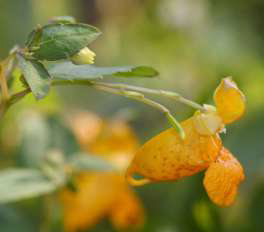 Jewelweed
Jewelweed
(Impatiens capensis Meerb.)
|
Classification |
| Kingdom: |
Plantae |
| Division: |
Magnoliophyta |
| Class: |
Magnoliopsida |
| Order: |
Geraniales |
| Family: |
Balsaminaceae |
| Genus: |
Impatiens |
| Species: |
I capensis Meerb. |
 Characteristics: Jewelweed is an annual with leaves that are somewhat triangular in shape with toothed margins. The flowers are orange colored, tubular shaped, and hooked at one end. The stems are somewhat translucent, but are succulent and have swollen or darkened nodes. The flowers may be found as early as June, but typically bloom in October. The seed pods are pendant shaped and when ripe have projectile seeds that explode out of the pods when they are lightly touched.
Characteristics: Jewelweed is an annual with leaves that are somewhat triangular in shape with toothed margins. The flowers are orange colored, tubular shaped, and hooked at one end. The stems are somewhat translucent, but are succulent and have swollen or darkened nodes. The flowers may be found as early as June, but typically bloom in October. The seed pods are pendant shaped and when ripe have projectile seeds that explode out of the pods when they are lightly touched.
Habitat: Jewelweed is common in rich bottomland soils, ditches, and along the edges of streams and marshes.
Range: It can be found throughout most of North America wherever the soil is moist enough to support it.
Native American Uses: Juice from jewelweed stems and leaves were used to alleviate poison ivy and stinging nettle rashes, as well as other skin irritations. A decoction of the stems was also taken to ease childbirth and an infusion of the leaves was used as a treatment for measles. The Cherokee and Chippewa Indians are Native American tribes that were known to utilize this species.
Modern Uses: The young sprouts can be eaten, and the juices of old plants can be applied to skin irritations,
such as those caused by poison ivy and stinging nettle.